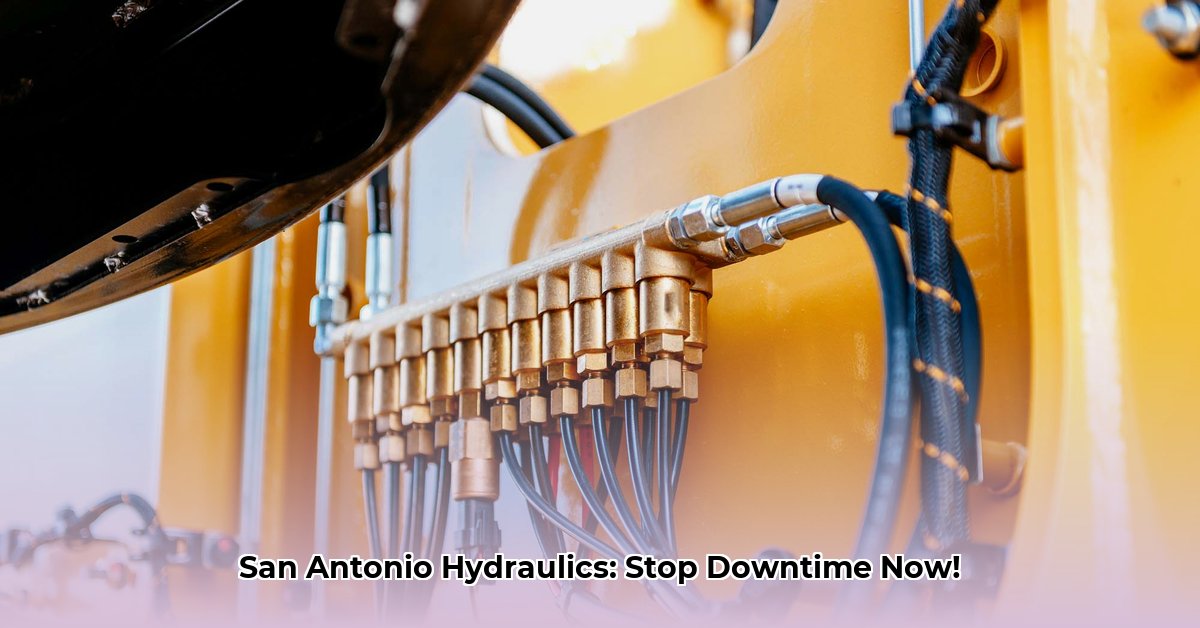
Hydraulic Supply San Antonio TX: Keeping Your Business Running Smoothly
In San Antonio's bustling industrial landscape, reliable hydraulic systems are the lifeblood of countless businesses. A single malfunction can trigger a cascade of problems: halted production, missed deadlines, and significant financial losses. This guide navigates the crucial process of finding the right hydraulic supply partner in San Antonio, ensuring your operations run smoothly and efficiently. We'll explore the advantages of local suppliers, implement preventative maintenance strategies, and guide you through selecting the ideal hydraulics provider.
The Local Edge: Speed, Expertise, and Community
Imagine a critical hydraulic system failure; every minute of downtime translates directly into lost revenue. A local San Antonio hydraulics supplier offers a distinct advantage: speed. Their proximity ensures rapid response times, minimizing downtime and dramatically reducing the financial impact of unexpected repairs. But the benefits extend beyond speed. Local suppliers often possess deep knowledge of the regional industrial landscape and build strong, collaborative relationships with their clients. This fosters a personalized service you won't find with larger, national companies. Isn't this personalized service crucial for consistent operational efficiency?
Preventative Maintenance: A Little Prevention Goes a Long Way
Proactive preventative maintenance significantly reduces the risk of catastrophic hydraulic failures. Regular inspections, fluid analysis, and component checks identify potential problems before they escalate into costly repairs. This approach not only extends the lifespan of your equipment but also minimizes operational disruptions. Think of it like regular checkups for your car—a small investment that prevents a major breakdown. Industry experts suggest that a well-structured preventative maintenance program can decrease unexpected repair costs by up to 40%, resulting in significant annual savings.
Choosing the Right Hydraulics Partner: A Step-by-Step Guide
Selecting the right hydraulics supplier requires careful consideration. Follow these steps for a successful partnership:
Assess Your Needs: Precisely identify your hydraulic component and service requirements. Create a detailed inventory of potential failure points within your hydraulic systems.
Research Local Suppliers: Utilize online resources, consult industry directories, and leverage word-of-mouth referrals to identify potential suppliers.
Obtain Quotes: Request detailed quotes from multiple suppliers, ensuring a comprehensive comparison of pricing and services.
Verify Expertise: Scrutinize each supplier's experience, certifications, and training programs to ensure they are qualified to handle your specific equipment.
Evaluate Inventory: Inquire about their inventory, parts availability, and the speed at which they can obtain specialized components. A supplier with readily available parts minimizes costly downtime.
Establish a Relationship: Effective communication is paramount. Prioritize suppliers known for clear, responsive communication. A strong, proactive relationship is invaluable in mitigating future issues.
Understanding the Risks: Potential Hydraulic System Failure Points
Recognizing potential failure points is crucial for proactive maintenance. Understanding these vulnerabilities allows for targeted preventative measures, significantly reducing the risk of costly downtime.
| Component | Potential Failure Risk | Impact of Failure | Mitigation Strategies |
|---|---|---|---|
| Hydraulic Pumps | Moderate | High | Regular maintenance; consider redundant pumps. |
| Hydraulic Hoses | Moderate | Moderate | Regular visual inspection; prompt replacement; high-quality hoses. |
| Hydraulic Valves | Moderate | High | Preventative maintenance; redundant valve systems. |
| Control Systems | High | Very High | Robust backup systems; regular software updates; skilled technicians. |
| Fluid Contamination | High | High | Regular fluid analysis; robust filtration systems. |
Beyond Parts: The Value of Comprehensive Services
Top-tier hydraulics suppliers offer much more than parts. They provide invaluable expertise, convenient on-site support, and specialized services such as custom hose fabrication and repair. These services eliminate time-consuming troubleshooting, preventing costly delays and maximizing operational efficiency.
Investing in the Future: Long-Term Strategies for Success
Predictive maintenance, utilizing sensor data and analytics to predict potential failures before they occur, represents a significant advancement in hydraulic system management. This proactive approach minimizes downtime, optimizes resource allocation, and maximizes return on investment. While the initial investment in sensors and software can be substantial, studies show that predictive maintenance can reduce maintenance costs by as much as 70% and significantly reduce equipment downtime. Partnering with a San Antonio hydraulics supplier experienced in predictive maintenance is crucial for long-term success. This proactive strategy is an investment that protects your business's future.
How to Compare Total Cost of Ownership for Local vs. National Hydraulic Repair Services
Choosing between local and national hydraulic repair services requires a thorough analysis of the total cost of ownership (TCO). This involves assessing all associated costs beyond the initial repair bill.
Understanding the Total Cost of Ownership (TCO)
TCO encompasses several key elements:
- Initial Repair Costs: The upfront price for the service.
- Downtime Costs: Lost production, missed deadlines, and potential penalties. Local service often minimizes this.
- Travel & Transportation: National providers often incur higher travel and shipping costs.
- Parts Costs: While national providers may have broader access to parts, local sourcing can sometimes be more cost-effective.
- Labor Costs: Labor costs will vary depending on location and provider.
- Warranty & Maintenance: Compare warranty durations and long-term maintenance agreements.
- Communication & Convenience: Factor in the ease and speed of communication and problem resolution.
Comparing Local vs. National Services: A Practical Approach
Define Your Needs: Carefully assess your hydraulic system's size, complexity, and the criticality of system uptime.
Gather Quotes: Secure detailed quotes from both local and national providers, ensuring all TCO elements are included.
Analyze Quotes: Create a side-by-side comparison, focusing on potential downtime costs and travel expenses.
Consider Intangibles: Evaluate communication responsiveness and personalized service levels. A local provider might offer more hands-on support.
Make Your Decision: Prioritize the overall TCO, considering factors beyond initial repair costs to determine the most cost-effective solution.
Preventative Maintenance: Your TCO Secret Weapon
Regardless of your chosen provider, implementing a robust preventative maintenance program is crucial for reducing long-term TCO. Regular maintenance drastically minimizes the likelihood of unexpected breakdowns and their associated costs. Remember, preventative maintenance is a strategic investment that safeguards your business from costly downtime in the long run.